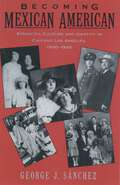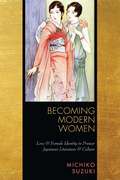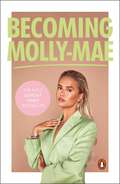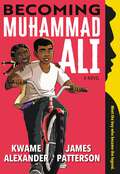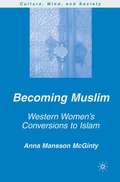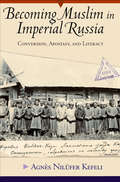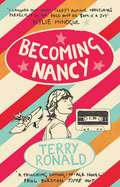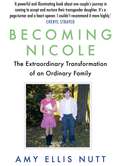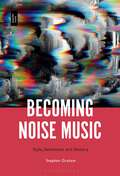- Table View
- List View
Becoming Mexican American: Ethnicity, Culture, and Identity in Chicano Los Angeles, 1900-1945
by George J. SanchezTwentieth-century Los Angeles has been the locus of one of the most profound and complex interactions between variant cultures in American history. Yet this study is among the first to examine the relationship between ethnicity and identity among the largest immigrant group to that city. By focusing on Mexican immigrants to Los Angeles from 1900 to 1945, George J. Sánchez explores the process by which temporary sojourners altered their orientation to that of permanent residents, thereby laying the foundation for a new Mexican-American culture. Analyzing not only formal programs aimed at these newcomers by the United States and Mexico, but also the world created by these immigrants through family networks, religious practice, musical entertainment, and work and consumption patterns, Sánchez uncovers the creative ways Mexicans adapted their culture to life in the United States. When a formal repatriation campaign pushed thousands to return to Mexico, those remaining in Los Angeles launched new campaigns to gain civil rights as ethnic Americans through labor unions and New Deal politics. The immigrant generation, therefore, laid the groundwork for the emerging Mexican-American identity of their children.
Becoming Mexican American: Ethnicity, Culture, and Identity in Chicano Los Angeles, 1900-1945
by George J. SanchezTwentieth-century Los Angeles has been the locus of one of the most profound and complex interactions between variant cultures in American history. Yet this study is among the first to examine the relationship between ethnicity and identity among the largest immigrant group to that city. By focusing on Mexican immigrants to Los Angeles from 1900 to 1945, George J. Sánchez explores the process by which temporary sojourners altered their orientation to that of permanent residents, thereby laying the foundation for a new Mexican-American culture. Analyzing not only formal programs aimed at these newcomers by the United States and Mexico, but also the world created by these immigrants through family networks, religious practice, musical entertainment, and work and consumption patterns, Sánchez uncovers the creative ways Mexicans adapted their culture to life in the United States. When a formal repatriation campaign pushed thousands to return to Mexico, those remaining in Los Angeles launched new campaigns to gain civil rights as ethnic Americans through labor unions and New Deal politics. The immigrant generation, therefore, laid the groundwork for the emerging Mexican-American identity of their children.
Becoming Middle Class: Young People’s Migration between Urban Centres in Ethiopia (Globalization, Urbanization and Development in Africa)
by Markus Roos BreinesThis book is an ethnography of urban-to-urban migration and its role in middle-class formation in Ethiopia. Through an examination of the intersections and tensions between physical movement and social mobility, it considers how young Tigrayan people’s migration between urban centres made them distinct from both international migrants and non-migrants. Based on fieldwork in Adigrat and Addis Ababa, it focuses on these young people’s notions of progress, experiences of higher education and ethnic tensions to demonstrate how their movements enabled them to enhance their economic, social and symbolic capital while their cultural capital remained largely unchanged. The book provides new insights into the opportunities and constraints for upward social mobility and argues that the emergence of shared characteristics among urban-to-urban migrants led to the formation of a group that can be described as a middle class in Ethiopia.
Becoming A Migrant Worker In Nepal: The Governmentality And Marketization Of Transnational Labor (Kultur Und Soziale Praxis Ser.)
by Hannah UpretyHigh-profile events such as the 2022 FIFA World Cup in Qatar have made one thing abundantly clear: Much of today's economic growth would be unthinkable without the low-wage employment of migrant workers. But which cultural, economic, and political infrastructures in the "source" countries make these types of migration possible in the first place? Based on multi-sensory ethnographic research in Nepal, Hannah Uprety retraces the practices of recruitment and instruction that - step by step - transform Nepali labor into an internationally marketable commodity. In doing so, she uncovers a migration regime that effectively turns local men and women into "migrant workers" before they even leave the country.
Becoming Miracle Workers: Language and Learning in Brief Therapy
by Gale MillerBrief therapy is a postmodern treatment mode that treats problems as social constructions, encouraging those seeking treatment to replace personal troubles (negative stories) with new problem-solving skills (positive stories). The significant differences discussed in this book do not involve sociologists and brief therapists. The differences are between brief therapists, on the one hand, and practitioners of psychotherapy and family therapy on the other. One indicator of these is brief therapists' describing the people who seek their services as clients. The terminology may be contrasted with the language of patients used by many other therapists. At the very least, this difference suggests how brief therapy departs from therapy approaches that are based on the medical model.Becoming Miracle Workers takes the reader inside "Northland Clinic," one of the most innovative and important centers of brief therapy in the world. Based on twelve years of research, Miller's book discusses how brief therapy has evolved into its present, postmodern form. He describes the details of brief therapist-client interactions, and the behind-the-scenes discussions among brief therapists about their clients' problems. This readable account of the workings of brief therapy invites readers to sit in on brief therapy sessions, provides them with new understandings of personal troubles as social constructions, and shows how brief therapists help their clients develop new, untroubled, life stories.
Becoming Miracle Workers: Language and Learning in Brief Therapy (Social Problems And Social Issues Ser.)
by Gale MillerBrief therapy is a postmodern treatment mode that treats problems as social constructions, encouraging those seeking treatment to replace personal troubles (negative stories) with new problem-solving skills (positive stories). The significant differences discussed in this book do not involve sociologists and brief therapists. The differences are between brief therapists, on the one hand, and practitioners of psychotherapy and family therapy on the other. One indicator of these is brief therapists' describing the people who seek their services as clients. The terminology may be contrasted with the language of patients used by many other therapists. At the very least, this difference suggests how brief therapy departs from therapy approaches that are based on the medical model.Becoming Miracle Workers takes the reader inside "Northland Clinic," one of the most innovative and important centers of brief therapy in the world. Based on twelve years of research, Miller's book discusses how brief therapy has evolved into its present, postmodern form. He describes the details of brief therapist-client interactions, and the behind-the-scenes discussions among brief therapists about their clients' problems. This readable account of the workings of brief therapy invites readers to sit in on brief therapy sessions, provides them with new understandings of personal troubles as social constructions, and shows how brief therapists help their clients develop new, untroubled, life stories.
Becoming Mobius: The complex matter of education
by Debra KiddBecoming Mobius is about living with uncertainty. Uncertainty is a state of being that many people struggle with both in day-to-day life and in education; being uncertain has almost become a sin. If we are truly to have an education system that 'works', we need to accept that learning and life are not simple, and we need to engage with difficult and complex ideas. Focusing on the process of learning and teaching, Dr Debra Kidd posits the possibility that wondering and wandering teachers might impact greatly on a child's ability to live with and thrive among uncertainties. She asks of us, not only as teachers or researchers, but simply as human beings, what are the things that affect us, and how can we remain attuned to all their possibilities while still functioning? Taking cues from neuroscience, physi, anthropology and philosophy, particularly that of Gilles Deleuze and Felix Guattari, but also Hannah Arendt, Jacques Derrida, Michel Foucault and others, Dr Kidd explores the nature and purpose of education through a series of different lenses. Details, moments, interactions and relationships are put under the microscope and their effects on teaching and learning examined. Becoming Mobius started life as Debra Kidd's doctoral thesis and draws on her extensive classroom experience, her own observations and research, and a broad base of educational thought; including the work of Gert Biesta, Masny's Multiple Literacies and more. In Becoming Mobius each chapter is presented as a plateau and maps the complexities of teaching and learning. This is a journey through a landscape of education. It is not a straight route. It is not a cop-out. It is a means of living in, with and through complexity and multiplicity. It is an attempt to bring forward a fresh vision of education. This is an honest, challenging and incredibly profound book that makes you stop and think - deeply - about what you do, why you do it and the effect it has. You will never look at teaching in the same light again. For anyone interested in thinking deeply about education.
Becoming Modern: Young Women and the Reconstruction of Womanhood in the 1920s (PDF)
by Birgitte SølandIn the decade following World War I, nineteenth-century womanhood came under attack not only from feminists but also from innumerable "ordinary" young women determined to create "modern" lives for themselves. These young women cut their hair, wore short skirts, worked for wages, sought entertainment outside the home, and developed new attitudes toward domesticity, sexuality, and their bodies. Historians have generally located the origins of this shift in women's lives in the upheavals of World War I. Birgitte Søland's exquisite social and cultural history suggests, however, that they are to be found not in the war itself, but in much broader social and economic changes.Søland's engrossing chronicle draws on a rich variety of sources--including popular media and medical works as well as archival records and oral histories--to examine how notions of femininity and womanhood were reshaped in Denmark, a small, largely agrarian country that remained neutral during the war. It explores changes in the female body and personality, the forays of young women into the public sphere, the redefinition of female respectability, and new understandings of married life as evidenced in both cultural discourses and social practices. Though specific in its focus, the book raises broad comparative questions as it challenges common assumptions about the social and sexual upheavals that characterized the Western world in the postwar decade. In a remarkably engaging fashion, it shows why the end of World War I did not lead to the return of "normal" life in the 1920s.
Becoming Modern: Young Women and the Reconstruction of Womanhood in the 1920s
by Birgitte SølandIn the decade following World War I, nineteenth-century womanhood came under attack not only from feminists but also from innumerable "ordinary" young women determined to create "modern" lives for themselves. These young women cut their hair, wore short skirts, worked for wages, sought entertainment outside the home, and developed new attitudes toward domesticity, sexuality, and their bodies. Historians have generally located the origins of this shift in women's lives in the upheavals of World War I. Birgitte Søland's exquisite social and cultural history suggests, however, that they are to be found not in the war itself, but in much broader social and economic changes.Søland's engrossing chronicle draws on a rich variety of sources--including popular media and medical works as well as archival records and oral histories--to examine how notions of femininity and womanhood were reshaped in Denmark, a small, largely agrarian country that remained neutral during the war. It explores changes in the female body and personality, the forays of young women into the public sphere, the redefinition of female respectability, and new understandings of married life as evidenced in both cultural discourses and social practices. Though specific in its focus, the book raises broad comparative questions as it challenges common assumptions about the social and sexual upheavals that characterized the Western world in the postwar decade. In a remarkably engaging fashion, it shows why the end of World War I did not lead to the return of "normal" life in the 1920s.
Becoming Modern Women: Love and Female Identity in Prewar Japanese Literature and Culture
by Michiko SuzukiPresenting a fresh examination of women writers and prewar ideology, this book breaks new ground in its investigation of love as a critical aspect of Japanese culture during the early to mid-twentieth century. As a literary and cultural history of love and female identity, Becoming Modern Women focuses on same-sex love, love marriage, and maternal love—new terms at that time; in doing so, it shows how the idea of "woman," within the context of a vibrant print culture, was constructed through the modern experience of love. Author Michiko Suzuki's work complements current scholarship on female identities such as "Modern Girl" and "New Woman," and interprets women's fiction in conjunction with nonfiction from a range of media—early feminist writing, sexology books, newspapers, bestselling love treatises, native ethnology, and historiography. While illuminating the ways in which women used and challenged ideas about love, Suzuki explores the historical and ideological shifts of the period, underscoring the broader connections between gender, modernity, and nationhood.
Becoming Molly-Mae
by Molly-Mae HagueThe real Molly-Mae, in her own wordsMolly-Mae Hague is no stranger to the limelight, having found fame on TV and online. But behind the polished exterior there is a young girl with a unique story. It's the Molly not everyone gets to see.In Becoming Molly-Mae she unravels herself completely for the first time to open up about how she nurtured her creativity from a young age, took ownership of her body image, battle self-doubt and built a happy life. Along the way she shares the moments, relationships and life lessons that have made her who she is. From the energetic child who loved Irish dancing and pageants, to the teenager holding down a job at Boots whilst building her dreams at fashion school, her journey to Love Island and how she copes with fame today.By sharing these parts of herself, Molly-Mae gives a fresh take on finding beauty and balance in a busy world.
Becoming Mr Nice: THE HOWARD MARKS ARCHIVE
by Amber MarksWelcome to the personal archives of Britain's biggest dope smuggler.For 40 years Howard Marks traversed the globe: an international businessman who became an inmate in America's toughest penitentiary before standing for election in the United Kingdom.Becoming Mr Nice reveals an extraordinary montage of previously unseen material from his roller-coaster life, interwoven with his daughter's incisively researched and deadpan commentary. It includes surveillance footage, intelligence reports, phone transcripts, the business cards and letterheads used as trading fronts, driving licences and passport applications in multiple identities, and cryptic faxes from the Far East. But more than that, it offers a vista onto his many and varied experiences and escapades, through notebooks, personal items and correspondence with the bizarre, wonderful, comic or downright suspicious characters who surrounded him.It includes extracts from a lavishly detailed and hitherto unpublished account of Howard's years on the run (written in confidence for the benefit of his otherwise baffled defence team) together with transcripts from his trial at the Old Bailey, in which he successfully claimed that his involvement in the biggest ever importation of cannabis into the United Kingdom was on behalf of the secret services.Peppered with comic observations from Howard's private letters, this book provides a uniquely personal insight into one of Britain's most remarkable characters. Becoming Mr Nice is the essential companion volume to Marks' million-copy-selling autobiography Mr Nice and a comprehensive, illustrated introduction to Howard Marks for a new generation.Praise for Becoming Mr Nice'Funny, brave and deeply personal, this remarkable book records the tenderness of father and daughter and the lives beyond the legend' - Salena Godden'Becoming Mr Nice is a brilliant read with so much that I didn't know' - Tim Burgess'If you enjoy charismatic / implausible / true romps from non-violent international cannabis smugglers, this is your book' - Ben GoldacrePraise for Howard Marks'An urban legend, a dedicated human rights campaigner, a smuggling overlord, a counterculture champion, a respected academic, an outstanding author, a DJ, a hilarious comedian, a skilful raconteur, and a loving father. A man who never compromised his values even in the face of overwhelming adversity' - Simon Doherty, Huff Post'The Marco Polo of the drug traffic' - Thomas V. Cash, special agent in charge of the Miami division of the American Drug Enforcement Agency (DEA)'True modern-day folk hero' - James Brown'Britain's best-known and most charming drug smuggler' - Guardian(Please note that due to the complex layout of this title and the number of illustrations included, some aspects of the design are compromised in the digital format. Although the eBook still provides the complete text and images, to experience the full impact of Becoming Mr Nice we recommend purchasing the hardback edition instead.)
Becoming Muhammad Ali (Becoming Ali)
by James Patterson Kwame AlexanderFrom two heavy-hitters in children's literature comes a biographical novel of cultural icon Muhammad Ali.Before he was a household name, Cassius Clay was a kid with struggles like any other. Kwame Alexander and James Patterson join forces to vividly depict his life up to age seventeen in both prose and verse, including his childhood friends, struggles in school, the racism he faced, and his discovery of boxing. Readers will learn about Cassius' family and neighbors in Louisville, Kentucky, and how, after a thief stole his bike, Cassius began training as an amateur boxer at age twelve. Before long, he won his first Golden Gloves bout and began his transformation into the unrivaled Muhammad Ali.Fully authorized by and written in cooperation with the Muhammad Ali estate, and vividly brought to life by Dawud Anyabwile's dynamic artwork, Becoming Muhammad Ali captures the budding charisma and youthful personality of one of the greatest sports heroes of all time.
Becoming Multicultural: Personal and Social Construction Through Critical Teaching (Critical Education Practice)
by Terry FordFirst Published in 1999. Routledge is an imprint of Taylor & Francis, an informa company.
Becoming Multicultural: Personal and Social Construction Through Critical Teaching (Critical Education Practice #Vol. 19)
by Terry FordFirst Published in 1999. Routledge is an imprint of Taylor & Francis, an informa company.
Becoming Muslim: Western Women's Conversions to Islam (Culture, Mind, and Society)
by A. Mansson McGintyWhile Islam has become a controversial topic in the West, a growing number of Westerners find powerful meaning in Islam. Becoming Muslim is an ethnographic study based on in-depth interviews with Swedish and American women who have converted to Islam.
Becoming Muslim in Imperial Russia: Conversion, Apostasy, and Literacy
by Agnès Nilüfer KefeliIn the nineteenth century, the Russian Empire’s Middle Volga region (today’s Tatarstan) was the site of a prolonged struggle between Russian Orthodoxy and Islam, each of which sought to solidify its influence among the frontier’s mix of Turkic, Finno-Ugric, and Slavic peoples. The immediate catalyst of the events that Agnès Nilüfer Kefeli chronicles in Becoming Muslim in Imperial Russia was the collective turn to Islam by many of the region’s Kräshens, the Muslim and animist Tatars who converted to Russian Orthodoxy between the sixteenth and eighteenth centuries. The traditional view holds that the apostates had really been Muslim all along or that their conversions had been forced by the state or undertaken voluntarily as a matter of convenience. In Kefeli’s view, this argument vastly oversimplifies the complexity of a region where many participated in the religious cultures of both Islam and Orthodox Christianity and where a vibrant Kräshen community has survived to the present. By analyzing Russian, Eurasian, and Central Asian ethnographic, administrative, literary, and missionary sources, Kefeli shows how traditional education, with Sufi mystical components, helped to Islamize Finno-Ugric and Turkic peoples in the Kama-Volga countryside and set the stage for the development of modernist Islam in Russia. Of particular interest is Kefeli’s emphasis on the role that Tatar women (both Kräshen and Muslim) played as holders and transmitters of Sufi knowledge. Today, she notes, intellectuals and mullahs in Tatarstan seek to revive both Sufi and modernist traditions to counteract new expressions of Islam and promote a purely Tatar Islam aware of its specificity in a post-Christian and secular environment.
Becoming Myself: A Psychiatrist’s Memoir
by Irvin Yalom'When Yalom publishes something - anything - I buy it, and he never disappoints. He's an amazing storyteller, a gorgeous writer, a great, generous, compassionate thinker, and - quite rightly - one of the world's most influential mental healthcare practitioners' Nicola Barker, Guardian Best Books of 2017'Wonderful, compelling and as insightful about its subject and about the times he lived in as you could hope for. A fabulous read' Abraham Verghese, author of Cutting for StoneIrvin D. Yalom has made a career of investigating the lives of others. In Becoming Myself, his long-awaited memoir, he turns his therapeutic eye on himself, delving into the relationships that shaped him and the groundbreaking work that made him famous.The first-generation child of immigrant Russian Jews, Yalom grew up in a lower-class neighbourhood in Washington DC. Determined to escape its confines, he set his sights on becoming a doctor. An incredible ascent followed: we witness his start at Stanford Medical School amid the cultural upheavals of the 1960s, his turn to writing fiction as a means of furthering his exploration of the human psyche and his rise to international prominence.Yalom recounts his revolutionary work in group psychotherapy and how he became the foremost practitioner of existential psychotherapy, a method that draws on the wisdom of great thinkers over the ages. He reveals the inspiration for his many seminal books, including Love's Executioner and When Nietzche Wept, which meld psychology and philosophy to arrive at arresting new insights into the human condition. Interweaving the stories of his most memorable patients with personal tales of love and regret, Becoming Myself brings readers close to Yalom's therapeutic technique, his writing process and his family life.
Becoming Nancy
by Terry RonaldFor David Starr, being cast as Nancy in the upcoming school production of Oliver! is quite a shock. But David is up to the challenge. Living in a three-bedroom semi in 1970s' working-class East Dulwich, surrounded by his somewhat colourful relatives, he is bright, smart-mouthed, fanatical about pop music and ready to shine. Rehearsals begin, and he strikes up a friendship with the handsome yet enigmatic Maxie Boswell, captain of the school football team. As their alliance deepens it appears they might become more than just good friends, but that can't be right, can it? Discovering a confidant in empathetic teacher, Hamish McClarnon, and spurred on by his no-nonsense best friend, Frances Bassey, David takes on the school bully, the National Front, and anyone else who threatens to stand in the way of true love.Vibrant, warm, and full of life, this uproarious and touching coming-of-age novel, set against the backdrop of South-East London in the thrill of the late seventies, will transport you straight back to your first music obsession and the highs and lows of your first love.
Becoming Neapolitan: Citizen Culture in Baroque Naples
by John A. MarinoNaples in the sixteenth and seventeenth centuries managed to maintain a distinct social character while under Spanish rule. John A. Marino's study explores how the population of the city of Naples constructed their identity in the face of Spanish domination.As Western Europe’s largest city, early modern Naples was a world unto itself. Its politics were decentralized and its neighborhoods diverse. Clergy, nobles, and commoners struggled to assert political and cultural power. Looking at these three groups, Marino unravels their complex interplay to show how such civic rituals as parades and festival days fostered a unified Neapolitan identity through the assimilation of Aragonese customs, Burgundian models, and Spanish governance. He discusses why the relationship between mythical and religious representations in ritual practices allowed Naples's inhabitants to identify themselves as citizens of an illustrious and powerful sovereignty and explains how this semblance of stability and harmony hid the city's political, cultural, and social fissures. In the process, Marino finds that being and becoming Neapolitan meant manipulating the city's rituals until their original content and meaning were lost. The consequent widening of divisions between rich and poor led Naples's vying castes to turn on one another as the Spanish monarchy weakened.Rich in source material and tightly integrated, this nuanced, synthetic overview of the disciplining of ritual life in early modern Naples digs deep into the construction of Neapolitan identity. Scholars of early modern Italy and of Italian and European history in general will find much to ponder in Marino's keen insights and compelling arguments.
Becoming Neolithic: The Pivot of Human History
by Trevor WatkinsBecoming Neolithic examines the revolutionary transformation of human life that was taking place around 12,000 years ago in parts of southwest Asia. Hunter-gatherer communities were building the first permanent settlements, creating public monuments and symbolic imagery, and beginning to cultivate crops and manage animals. These communities changed the tempo of cultural, social, technological and economic innovation. Trevor Watkins sets the story of becoming Neolithic in the context of contemporary cultural evolutionary theory. There have been 70 years of international inter-disciplinary research in the field and in the laboratory. Stage by stage, he unfolds an up-to-date understanding of the archaeology, the environmental and climatic evidence and the research on the slow domestication of plants and animals. Turning to the latest theoretical work on cultural evolution and cultural niche construction, he shows why the transformation accomplished in the Neolithic began to accelerate the scale and tempo of human history. Everything that followed the Neolithic, up to our own times, has happened in a different way from the tens of thousands of years of human evolution that preceded it. This well-documented account offers a useful synthesis for students of prehistoric archaeology and anyone with an interest in our prehistoric roots. This new narrative of the first rapid transformation in human evolution is also informative to those interested in cultural evolutionary theory.
Becoming Neolithic: The Pivot of Human History
by Trevor WatkinsBecoming Neolithic examines the revolutionary transformation of human life that was taking place around 12,000 years ago in parts of southwest Asia. Hunter-gatherer communities were building the first permanent settlements, creating public monuments and symbolic imagery, and beginning to cultivate crops and manage animals. These communities changed the tempo of cultural, social, technological and economic innovation. Trevor Watkins sets the story of becoming Neolithic in the context of contemporary cultural evolutionary theory. There have been 70 years of international inter-disciplinary research in the field and in the laboratory. Stage by stage, he unfolds an up-to-date understanding of the archaeology, the environmental and climatic evidence and the research on the slow domestication of plants and animals. Turning to the latest theoretical work on cultural evolution and cultural niche construction, he shows why the transformation accomplished in the Neolithic began to accelerate the scale and tempo of human history. Everything that followed the Neolithic, up to our own times, has happened in a different way from the tens of thousands of years of human evolution that preceded it. This well-documented account offers a useful synthesis for students of prehistoric archaeology and anyone with an interest in our prehistoric roots. This new narrative of the first rapid transformation in human evolution is also informative to those interested in cultural evolutionary theory.
Becoming New York's Finest: Race, Gender, and the Integration of the NYPD, 1935-1980
by A. DarienAfter excluding women and African Americans from its ranks for most of its history, the New York City Police Department undertook an aggressive campaign of integration following World War II. This is the first comprehensive account of how and why the NYPD came to see integration as a highly coveted political tool, indispensable to policing.
Becoming Nicole: The Extraordinary Transformation of an Ordinary Family
by Amy Ellis Nutt'Becoming Nicole is a powerful and illuminating book about one couple's journey in coming to accept and nurture their transgender daughter. It's a page turner and a heart opener. I couldn't recommend it more highly.' Cheryl Strayed, author of WildWhen Wayne and Kelly Maines adopted identical twin boys, they thought their lives were complete. But it wasn't long before they noticed a marked difference between Jonas and his brother, Wyatt. Jonas preferred sports and trucks and many of the things little boys were 'supposed' to like; but Wyatt liked princess dolls and dressing up and playing Little Mermaid. By the time the twins were toddlers, confusion over Wyatt's insistence that he was female began to tear the family apart.Becoming Nicole is the heart-wrenching story of a mother whose instincts told her that her child needed love and not disapproval; of a conservative, army-veteran father who overcame his deepest fears to embrace his new daughter; of a loving brother who never gave up supporting his twin sister; and of a town forced to confront its own prejudices. More than that, however, Becoming Nicole is the story of an extraordinary girl who fought for the right to be herself.
Becoming Noise Music: Style, Aesthetics, and History
by Stephen GrahamBecoming Noise Music tells the story of noise music in its first 50 years, using a focus on the music's sound and aesthetics to do so. Part One focuses on the emergence and stabilization of noise music across the 1980s and 1990s, whilst Part Two explores noise in the twenty-first century. Each chapter contextualizes – tells the story – of the music under discussion before describing and interpreting its sound and aesthetic. Stephen Graham uses the idea of 'becoming' to capture the unresolved 'dialectical' tension between 'noise' disorder and 'musical' order in the music itself; the experiences listeners often have in response; and the overarching 'story' or 'becoming' of the genre that has taken place in this first fifty or so years. The book therefore doubles up on becoming: it is about both the becoming it identifies in, and the larger, genre-making process of the becoming of, noise music. On the latter count, it is the first scholarly book to focus in such depth and breadth on the sound and story of noise music, as opposed to contextual questions of politics, history or sociology. Relevant to both musicology and noise audiences, Becoming Noise Music investigates a vital but analytically underexplored area of avant-garde musical practice.
